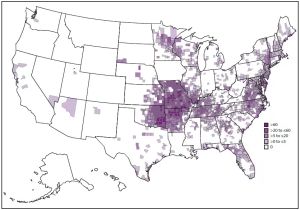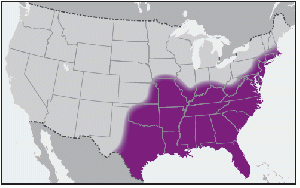Ehrlichiosis: Difference between revisions
Neil.m.young (talk | contribs) (Text replacement - "2 mg" to "2mg") |
|||
| (10 intermediate revisions by 7 users not shown) | |||
| Line 1: | Line 1: | ||
==Background== | ==Background== | ||
[[File:Ehrlichia.jpg|thumb|Reported incidence rate of Ehrlichia chaffeensis ehrlichiosis 2000–2013 (per 1,000,000 persons per year).]] | |||
[[File:Lone Star Tick.jpg|thumb|Lone Star Tick (preserved]] | |||
[[File:Rr6502a1f13.gif|thumb|Approximate U.S. distribution of Amblyomma americanum (lone star tick).]] | |||
*Bacterial infection of the family Anaplasmataceae common in mammals such as cattle, dogs, sheep, goats, and horses<ref>CDC. Ehrlichiosis. http://www.cdc.gov/ehrlichiosis.</ref> | *Bacterial infection of the family Anaplasmataceae common in mammals such as cattle, dogs, sheep, goats, and horses<ref>CDC. Ehrlichiosis. http://www.cdc.gov/ehrlichiosis.</ref> | ||
*Spread by the Lonestar tick (Amblyomma americanum) | *Spread by the Lonestar tick (Amblyomma americanum) | ||
**Eastern seaboard from Florida to Maine and as far west as Iowa and Texas | **Eastern seaboard from Florida to Maine and as far west as Iowa and Texas | ||
**States with the highest incidence:<ref>Sexton DJ and McClain MT. Human ehrlichiosis and anaplasmosis. UpToDate.</ref> | |||
***Rhode Island (36.5 cases per million) | |||
***Minnesota (3.9 to 12.3 cases per million) | |||
***Connecticut (8.1 to 15.9 cases per million) | |||
**People often unaware they are bitten with case fatality rate of approximately 1.8%<ref>CDC http://www.cdc.gov/ehrlichiosis/stats/</ref> | **People often unaware they are bitten with case fatality rate of approximately 1.8%<ref>CDC http://www.cdc.gov/ehrlichiosis/stats/</ref> | ||
**More severe disease in immunocompromised patients ([[HIV]], Elderly, '''Asplenic''') | **More severe disease in immunocompromised patients ([[HIV]], Elderly, '''[[Asplenic]]''') | ||
==Clinical Features== | ==Clinical Features== | ||
*Fever | *Variable spectrum of severity of disease | ||
**Up to 60% | *[[Fever]]/chills (abrupt onset), malaise, myalgias | ||
*[[Headache]] | |||
*[[Nausea/vomiting]], [[diarrhea]] | |||
*Conjunctival injection | |||
*[[Rash]] | |||
**Up to 60% in children, 30% of adults | |||
==Differential Diagnosis== | ==Differential Diagnosis== | ||
{{Tick borne illnesses DDX}} | {{Tick borne illnesses DDX}} | ||
== | ==Evaluation== | ||
*'''Peripheral blood smear'''<ref>http://www.cdc.gov/ehrlichiosis/symptoms/index.html#diagnosis</ref> | *'''Peripheral blood smear'''<ref>http://www.cdc.gov/ehrlichiosis/symptoms/index.html#diagnosis</ref> | ||
*Obligate intracellular organism | *Obligate intracellular organism | ||
| Line 28: | Line 38: | ||
*'''Enzyme Immunoassay''' | *'''Enzyme Immunoassay''' | ||
**Qualitative tests, not quantitative | **Qualitative tests, not quantitative | ||
*Leukopenia, | *Leukopenia, thrombocytopenia, and transaminitis often present | ||
==Management== | ==Management== | ||
{{Ehrlichiosis antibiotics}} | |||
==Disposition== | ==Disposition== | ||
* | *Most cases are treated as an outpatient | ||
==See also== | ==See also== | ||
Latest revision as of 18:11, 30 July 2025
Background
- Bacterial infection of the family Anaplasmataceae common in mammals such as cattle, dogs, sheep, goats, and horses[1]
- Spread by the Lonestar tick (Amblyomma americanum)
- Eastern seaboard from Florida to Maine and as far west as Iowa and Texas
- States with the highest incidence:[2]
- Rhode Island (36.5 cases per million)
- Minnesota (3.9 to 12.3 cases per million)
- Connecticut (8.1 to 15.9 cases per million)
- People often unaware they are bitten with case fatality rate of approximately 1.8%[3]
- More severe disease in immunocompromised patients (HIV, Elderly, Asplenic)
Clinical Features
- Variable spectrum of severity of disease
- Fever/chills (abrupt onset), malaise, myalgias
- Headache
- Nausea/vomiting, diarrhea
- Conjunctival injection
- Rash
- Up to 60% in children, 30% of adults
Differential Diagnosis
Tick Borne Illnesses
- Babesiosis
- Colorado tick fever
- Ehrlichiosis
- Heartland virus
- Lyme
- Murine typhus
- Rocky mountain spotted fever
- Southern tick-associated rash illness (STARI)
- Tick paralysis
- Tularemia
Evaluation
- Peripheral blood smear[4]
- Obligate intracellular organism
- Smear shows intracellular parasites only 20% of time
- PCR
- Most sensitive in first week of illness
- Indirect Immunoflorescence Assay'
- Gold Standard
- Negative 85% of time in first 7 days of illness
- Compare 2 samples drawn at different times
- 4 fold increase in titers of second draw is positive
- Enzyme Immunoassay
- Qualitative tests, not quantitative
- Leukopenia, thrombocytopenia, and transaminitis often present
Management
Antibiotics should be continued for 5 days after the last recorded fever.
- Adults: Doxycycline 100mg PO/IV BID x 14 days
- Pediatrics: under 45 kg use Doxycycline 2.2mg/kg PO/IV twice a day
- Pregnant: Rifampin 300mg PO every 12 hours
Disposition
- Most cases are treated as an outpatient
See also
References
- ↑ CDC. Ehrlichiosis. http://www.cdc.gov/ehrlichiosis.
- ↑ Sexton DJ and McClain MT. Human ehrlichiosis and anaplasmosis. UpToDate.
- ↑ CDC http://www.cdc.gov/ehrlichiosis/stats/
- ↑ http://www.cdc.gov/ehrlichiosis/symptoms/index.html#diagnosis





